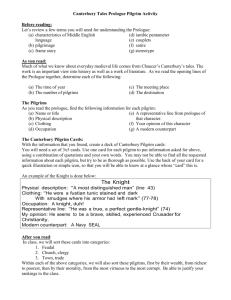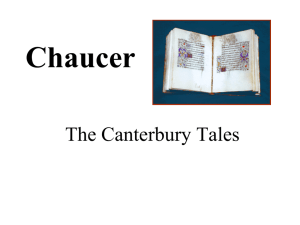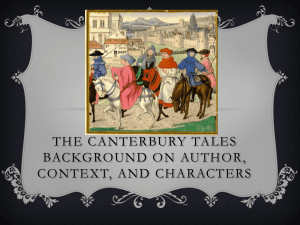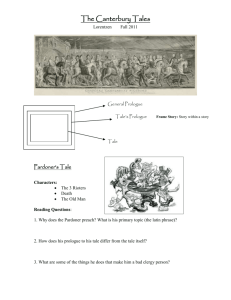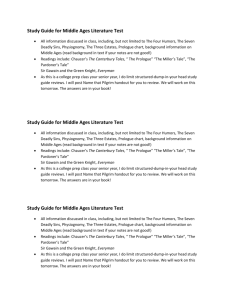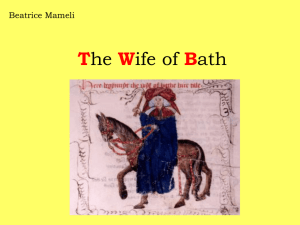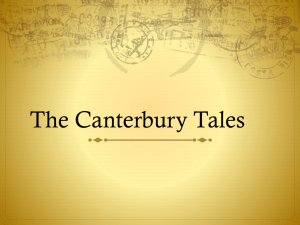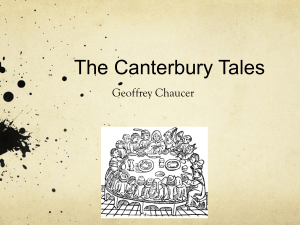Canterbury-Tales
advertisement
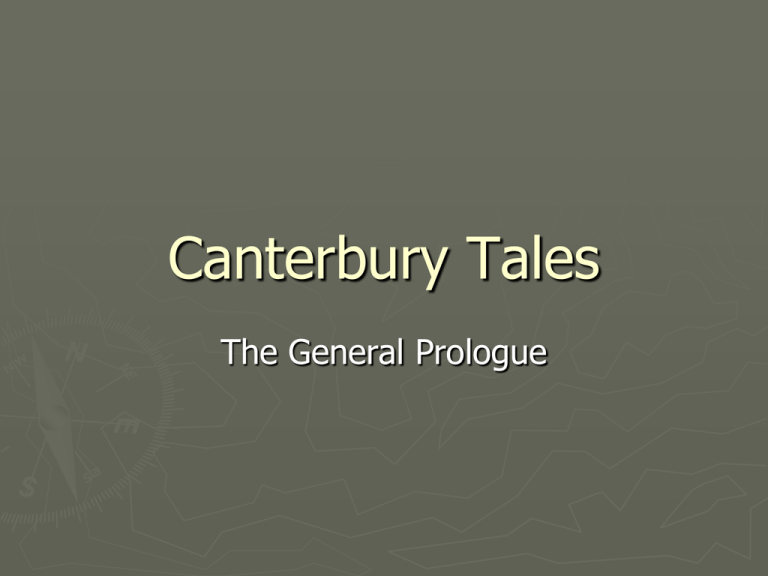
Canterbury Tales The General Prologue Canterbury Tales ► Written around 1387-1400 ► Written by Geoffrey Chaucer Soldier Courtier Royal emissary to Europe Controller of customs Justice of the peace Member of Parliament artist Prologue ► Chaucer has the idea to bring together 29 “sondry folk” in a pilgrimage (“by aventure [chance]”) Represent a wide range of 14th century English society ►Makes comprehensive study of humans ►Perfect way to present his irony Prologue ► Represent society a wide range of 14th century English 3 Groups Represent: ► Agricultural feudalism Landownership and service ► Knight’s yeoman ► Franklin ► Urbanization Change in feudal structure ► Doctor ► Guildsmen ► The Church One of the most powerful elements in medieval soceity ► 9 of pilgrims belong to clergy Prologue ► Each pilgrim tell two stories on the way to Canterbury two stories on the way back ►Plan Inn ► Teller proposed by Harry Bailey, host of the Tabard of best tale is rewarded at the end A dinner provided by his fellow pilgrims at the Tabard ►Harry Bailey is judge Prologue ► Prologue sets the scene and introduces reader to the characters ► Between many of the tales Chaucer expounds upon the personalities of the pilgrims. Number of arguments that prepare for subsequent tales Some pilgrims introduce a tale with a commentary on his/her own personal life Prologue ► Chaucer’s project was never finished Only 24 tales exist ► Tales were probably composed at various times in Chaucer’s life Prologue ► Begins with a long, rhetorical sentence in “high style” describing spring. ► Gradually descends into a more “realistic” style of expository narrative. Prologue ► Group is on its way to the holy shrine of St. Thomas ă Becket Archbishop of Canterbury ►opposed Henry II over the balance between royal and religious power ►was murdered in the cathedral Considered a martyr and later made a saint His blood was held to contain great curative qualities, restoring health to the sick The Knight ► Was an honorable warrior who fought for Christianity against the heathens. ► Appropriate that he is the first pilgrim to be introduced because he stands at the top of the social hierarchy, thus is the most socially prominent person on the journey. ► Tells the first story; many offer him compliments. ► All of the battles mentioned that he fought in were religious wars of some kind. The Knight ► Prologue’s description: Worthy man Loved the following ►Chivalry ►Fidelity ►Honor (good reputation) ►Generosity ►courtesy Honored for his worthiness in war The Knight ► Prologue’s description: Fought in many battles/ had “been at many a noble expedition” ► Alexandria ► Prussia ► Lithuania/Latvia ► Russia ► Grenada at siege of Algeciras to Belmarye (north Africa) ► Morocco ► The Mediterranean ► Tiemcen ► Turkey The Knight ► Prologue’s description: Even though he was brave, he was prudent Deportment: “meek as a maid” Never said any rude word in all his life to any person Horses were good Clothing/dress ►Not gaudily dressed ►Tunic of coarse cloth, stained with rust from his chain mail suit Has just returned from an expedition The Knight’s Tale adapted from Boccaccio’s Teseide ► Tale of ideal love and chivalry. ► Would be a popular type of tale in Chaucer’s day. ► Probably The Knight’s Tale ► Premise: Two Thebian knights, Palamon & Arcite, fall in love with the same woman, Emelye, whom they see only from their prison window in Athens. Their life-long friendship is immediately disrupted by their rivalry for Emelye. In time Arcite is released from prison on the condition that he never again set foot in Athens. Palamon eventually escapes years later. The Knight’s Tale ► The men meet by chance in a grove hear Athens and are about to fight when Theseus and his company interrupt them. ► After forgiving the knights for their past, Theseus schedules a tournament (50 weeks later) for the hand of Emelye. ► Arcite wins the tournament, but scarcely has had time to claim his fair prize when the misaligned planet Saturn causes him to fall from his horse and die shortly afterward. The Knight’s Tale ► Palamon forgets his ill feelings toward Arcite and retires to Thebes, where he mourns his former friend. ► Several years later, Theseus summons Palamon, who is still mourning and wearing black, and gives him Emelye in marriage. ► Makes of two sorrows one “parfit joye, lastynge everemo.” The Knight’s Tale ► Not much action in the romance. ► Two knights are almost the same Both ►Make speeches declaring their love ►Curse their destiny ►Pray to their respective gods The Knight’s Tale ► Conflict that a story about medieval knights and their customs would be set in ancient Greece. ► Knight ► Squire ► Yeoman ► Prioress ► Monk ► Friar ► Merchant ► Clerk ► Sergeant ► Franklin ► Guildsmen ► Cook ► Shipman ► Doctor ► Wife of Bath ► Parson ► Miller ► Manciple ► Reeve ► Summoner ► Pardoner ► Poet ► Host (innkeeper Harry Bailey)

